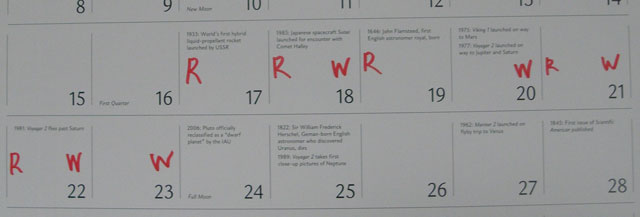20x2x20 Week 1
A week ago I laid out my plan to try and spend a hour a day working on personal projects. Now that I've been at this a week I thought I'd assess if it was working. Turns out the "work method" I'm using already had a name called Pomodoro Technique as one of the commenters pointed out. While I'm using 20 minutes instead of 25, it is nice to know that others have found such a pattern helpful. The other part I wanted was some visual reenforcement of my progress and status. For that I chose a simple offline method.

Each day I'm marking the calendar that hangs next to my desk with an R if I spent my 20 minutes reading or with a W if I spent my 20 minutes writing. Thinking more about the goal to get back into the habit of working on personal projects I'm finding myself more interested in doing a little work every day instead of marathon sessions that I'm prone to. I know some of those writing sessions on the weekend were much longer than 20 minutes, but the fact that I've not been procrastinating about doing them to me is the bigger goal than the total hour count.
Along those same lines, thinking about the 20 days number, if I instead think of that as 20 days over 4 weeks or 20 days out of 28 days, that means I'm skipping each task twice a week. That feels about the right kind of flow and adjustment for doing other fun stuff. Net result: week 1 was a success and now onto week 2.
